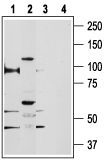Overview
- Peptide (C)GLNLSEGDGEEVYHF, corresponding to amino acid residues 715-729 of human TRPV5 (Accession Q9NQA5). Intracellular, C-terminus.
- Rat kidney, human prostate cancer–PC3 (1:200). It is highly recommended to add 0.1-0.5% Triton X-100 to the antibody solution.
 Western blot analysis of rat kidney (lanes 1 and 3) and human PC3 prostate cancer cell line (lanes 2 and 4) lysates:1,2. Anti-TRPV5 Antibody (#ACC-035), (1:200).
Western blot analysis of rat kidney (lanes 1 and 3) and human PC3 prostate cancer cell line (lanes 2 and 4) lysates:1,2. Anti-TRPV5 Antibody (#ACC-035), (1:200).
3,4. Anti-TRPV5 Antibody, preincubated with TRPV5 Blocking Peptide (#BLP-CC035).
- Rat kidney paraffin embedded section (1:100). Mouse kidney sections (Loh, N.Y. et al. (2013) PLoS ONE 8, e55412.).
- PC-3 cells (1:100).
TRP channels are a large family (about 28 genes) of plasma membrane, non-selective cationic channels that are either specifically or ubiquitously expressed in excitable and non-excitable cells.1 According to IUPHAR, the TRP family is comprised of three main subfamilies on the basis of sequence homology; TRPC, TRPM and TRPV (to date, three extra subfamilies are considered to belong to the TRP family; the TRPA, TRPML, and TRPP).1-4 The TRPV subfamily consists of six members, TRPV1-6.5
TRPV5 (ECaC) and TRPV6 (CaT1) are unique members of the TRP family. Both are epithelial Ca2+ channels, form constitutively open channels, share high degree of homology (about 66%) with differences in the N- and C-terminus. TRPV6 and TRPV5 are expressed in a 1,25-dihydroxyvitamin D3 dependent manner. In contrast to other members of the TRP family, TRPV5 and TRPV6 are highly Ca2+ selective and are expressed in Ca2+ transporting epithelia where they are assumed to have an important role in Ca2+ reabsorption.6,7 TRPV5 is preferentially expressed in the kidney.
